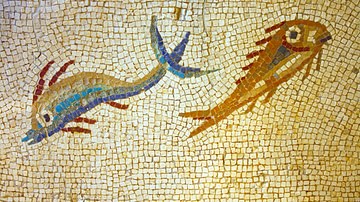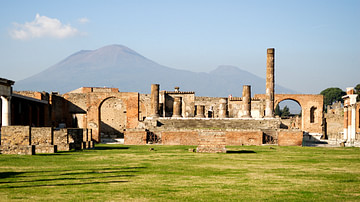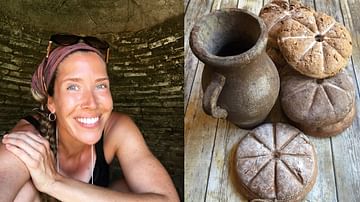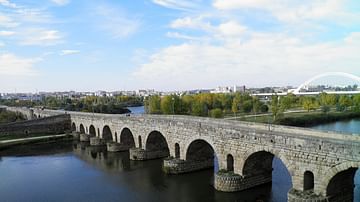The ancient Romans left behind a wealth of remains which help archaeologists and historians to understand what daily life was like in the Roman Empire. From ancient frescos of rich table spreads, to broken wine vessels, carbonized loaves of bread, and petrified olive pits, the left-overs of Rome's food culture are all around.
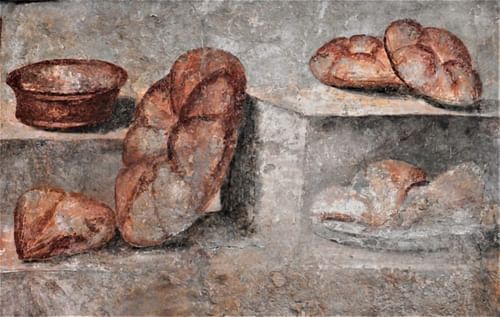
In this exclusive interview Arienne King, Media Editor at Ancient History Encyclopedia (AHE), speaks with Farrell Monaco, an archaeologist specializing in the culinary practices and food culture of the Roman Mediterranean, and the author of the blog Tavola Mediterranea. Drawing on her own experience, Monaco talks about ancient Roman cuisine and the challenges of food history, experimental archaeology, and public outreach.
AK: Hi Farrell, thank you for speaking with me on behalf of Ancient History Encyclopedia. To break the ice, I wanted to ask what first got you interested in ancient history and archaeology?
FM: If I am to be 100% honest, it was as a child when I saw Raiders of the Lost Ark for the first time. I was hooked from then on. I'd say many an archaeologist in my age-group probably had the same epiphany! My father noticed this interest when I was a child as well, and he nurtured it a great deal by buying me archaeology books, giving me replicated artefacts (arrowheads, icons, etc) to catalogue and study, and taking me to museums. He had a huge influence on my historical and archaeological interests as a child and then as an adult, I took it in a direction that suited me best: food!
AK: I think a lot of people got hooked on history and archaeology in a similar fashion. For me it was watching The Mummy (1999)!
FM: I am a huge proponent of archaeological entertainment, if it gets the public interested! Yes, sometimes it's not accurate, but if it's fictional entertainment, no one can complain. It's all in good fun. But if it gets kids or adults interested in digging deeper into the real data, then it serves the discipline well.
AK: At this point, I have to ask: Why food history in particular? What is it about ancient eating patterns and food cultures that resonates with you?
FM: I suppose I gravitated towards it as I am a food-lover to begin with. Not a foodie, per se (I dislike that term as it's elitist in nature) but I have always enjoyed cooking, baking, experimenting in the kitchen and learning about the foods of other cultures. My interest in food archaeology, and the sensory aspects of it, began when I was working on food-related archaeology digs in Italy (Monte Testaccio, for example) where the focus was on food-related data but not the food itself.
For example: Olive oil amphorae, tituli picti, commercial relationships, trade routes.... but not the olive oil! What did it taste like? Sharp or bland? How did Romans use it? What did they put it on? Was good oil eaten and cheap oil used for lamps? …
We see so often in archaeological writing the descriptions of 'daily life' but rarely do we touch on food in the daily lives in the sensory aspect. We are governed by taste, aroma and texture. We eat the same things repeatedly because it brings us pleasure. The Romans were the same. I am interested in what their 'tastes' were and in their culinary practices and thankfully, they left a formidable archaeological record with which to draw on to get this information. Also written and pictorial records. This data, coupled with Experimental and Sensory (Experiential) Archaeology, in my opinion, allows archaeologists to get much closer to understanding the food in the Roman world and Roman food preferences.
AK: There has been a bit of an upswing in public interest with regards to food history, something both educational outlets and food brands are paying attention to. What do you think it is about food history captures the interest of so many people?
FM: I think the response to food history in recent years is part and parcel with a general shift in focus in our society around our food and our food supply. All we have to do is turn on Netflix, CNN or the Food Channel to see how interested people are becoming in food culture, food preparation, and food stories, in general. Some of it is political in nature and some of it is pure entertainment, but there is a renaissance of food culture happening right now and I like to think that it is a collective human response to our recent disconnection to food that occurred during the post-war years when increased urbanization occurred and industrialization of food production took over.
Urbanization, leaving the farm, our dependence on restaurants and grocery stores, women leaving the home to work, has subsequently disconnected us in many ways from our understanding of food, agriculture, animal management/husbandry (dairy/meat supply) etc. Not that any of this is a bad thing, per se, but it is a result of evolution and change. I feel that we are turning around and looking at our history and food history to connect again with something that is a part of what we are. It's also key to bringing us all together both on a local and global scale. Food archaeology to me is part of this. If we understand that value that our fore-mothers and fore-fathers placed on food cultivation and preparation, we may place a higher value on it in our day and age as well.
AK: Those are some great points that I had never considered. It makes sense that the deeply human connection to farm and food is a powerful means of reconnecting with the past. When you get down to it, the advent of agriculture was perhaps the catalyst for civilisation, so it is only natural to study history by tracing mankind's eating habits.
FM: I think that there are a lot of parallels when we look at food history and food archaeological data as well. We understand people in the past much better when we can observe them engaging in food culture in some of the same ways that we do.
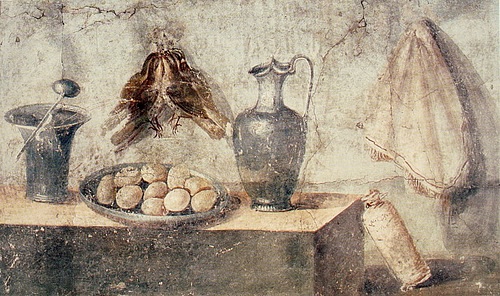
Food and identity, for example. I look at Roman food frescoes and what I see is a projection of access, beauty, and taste painted on to the wall of a Roman villa. Someone decided to take the time to have that food image painted in order to convey something to their guests that said something about them. I see food that they have access to, food that they enjoy eating because it tastes good to them, and food that they consider to be beautiful enough to paint on to the wall (form, colour, etc).
This is the same thing that we do on Instagram and Facebook when we share a picture of our lunch for all of our friends/followers. We are projecting an image of what we have access to, where we are, who we are with, what we are eating etc, and this says a lot about who we are: our identity and how we want to be seen by others.
AK: You mentioned that "we are governed by taste, aroma and texture" and that the Romans similarly had their own tastes and food preferences. On the one hand, the Mediterranean Triad (grapes, olives, wheat) were omnipresent, but then you have staples like garum or expensive additives like silphium that would be unfamiliar. Would you say that Roman cuisine, for lack of a better term, would be more or less similar in terms of flavour profiles to a modern Mediterranean diet?
FM: Not necessarily. Regional flavours in the Mediterranean are somewhat localized nowadays when we think of modern Italian, Greek, or Egyptian food, for example. There's little fusion, in that regard. The flavours and aromas that come to mind right now with respect to ancient Roman food is a result of their movements around the Mediterranean. Appropriation of other foods from other confiscated lands. The Romans inherited their food culture from many sources. This included their own pre-Roman tribal sources (Latins, Samnites, Oscans etc), but there were also culinary influences from Phoenicia, Carthage, Greece, Egypt, Judea, Syria etc.
Cereal grains were the backbone of the Roman diet and the average Joe (or Lucius...) consumed most of their daily calories in the form of grain products such as bread and puls (porridge).
From my experimental food archaeology projects related to Roman food, I have discovered thus far that their food preparation practices and 'recipes' were quite bold and sophisticated. Flavours that I recall from some of the most memorable recipes that I've interpreted are: bold, sharp, bitter, strong, full-bodied. For example, using wine and vinegar reductions in cooking, and sweet and sour flavours in use with meat. Ingredients like garum (a salted fish condiment) and lovage. Exquisite custards and patinae (soufflés), or cheese dishes that incorporate ingredients we would genuinely be hesitant to combine in this day and age, but the end-product is incredible.
[The now extinct plant] silphium was used in many dishes. The Romans picked silphium to extinction as it was so prized by the elite class. Asafoetida (also known as hing) was suggested as a poor man's substitute, even in Antiquity, as the strong, pungent flavour that silphium had was a desired additive in Roman cooking. It was Cyrenian (Libyan).
I could go on but I'll let you ask the questions. A good area to speak of is that Romans did not waste food either. Something we could all learn from.
AK: That is an interesting point. The Romans were quite thrifty, and even used or broken amphorae [clay vessels typically filled with oil or wine] were reused in different ways, before finally being discarded. Would you mind expanding a bit on food wastage (or lack thereof) in the Roman Empire?
FM: You're correct! Amphorae turn up everywhere and in many different contexts. They were disposed of in heaps like Monte Testaccio, used as wall-fill, or as cooking tiles (which were heated and used to cover food in a hearth). They were even used to cover bodies during funereal burials. The Romans were brilliant when it came to recycling and repurposing. They didn't waste much. With respect to food, it makes complete sense as famine was a very real threat for Romans.
They were continually trying to find ways to feed the capital (the city of Rome) by expanding and appropriating more and more land and farming territories. When we look at the Mediterranean Triad, for example, Roman grew grapes and pressed them to make wine. But they kept the must (grape skins) and used them further. They would boil them and reduce them (sometimes in lead-lined pots!) to create a food preservative and additive called 'Defrutum'. And it's absolutely delicious!
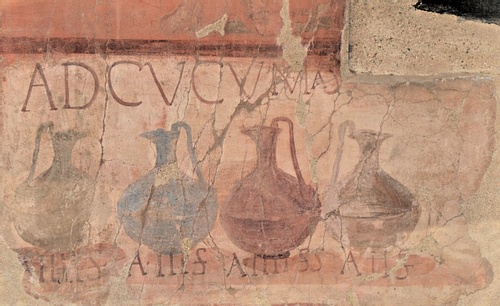
The primary product of olives was oil for food, cleansing the skin, medicine and lamp fuel... but the Romans knew the olive pits were combustible so they used them as kindling in bread ovens and hearths, etc. The use of all parts of an animal for food (and I mean every part) is a signature Roman practice. Reading Apicius' 1st Century CE cookbooks is not only intriguing but stomach-turning on occasion as well!
AK: A little earlier, you brought up the relationship between food history and archaeology. In addition to studying ancient frescoes and analyzing carbonized bread from 2,000 years ago, you also use experimental archaeology to unravel the secrets of ancient Roman cuisine. What have you found are the strengths and challenges of using experimental archaeology in this way?
FM: To me, experimental archaeology is key to the interpretive process. It makes no sense to me why we should assess and interpret an object, for example, by only using our eyes. Looking at something through a glass cabinet and not understanding how we would handle it and use it is a disadvantage. I have always felt that if we want to understand something, we should make it or use it ourselves. Observe through experience and be cognizant of our senses in the process.
For example, a manual grain mill. How am I handling it? What does it sound like? Am I sweating because I'm exerting energy? Is my back sore now? Are my hands shaking from using it for 2 hours straight? What does the grain look and feel like? Is the flour dust in my eyes and up my nose because it's in the air around me? Is it irritating my eyes or throat? And finally, what's the flour texture like? The bread product? What can I eat with? Is it bland? Filling?
All of this paints a much broader picture of what domestic milling and bread-making was like in ancient Rome and it gives us a very clear idea as to how much time was taken up in a day to feed oneself, how much labour was pored into it, how difficult it was to procure and prepare food, and how much value was placed on food as a result. You DO NOT get this experience by looking at a kitchen implement in a cabinet at a museum. You arrive at this understanding by engaging in Experimental and Sensory Archaeology. It broadens the interpretive scope significantly. It's almost like walking a mile in a Roman's shoes.
AK: Interesting! Experimental archaeology seems to lend itself well to food and food manufacturing.
FM: As for challenges...I don't get to use the original food-processing technologies! But this could also be hazardous to my health: For example, leucetite grain mills may have produced grit that could damage my teeth, and I certainly DON'T want to experiment with cooking in lead-lined pots.
AK: I can see how there are certain risks which you might aim to avoid, and certain conditions which can not be replicated. Plenty of Egyptian mummies with worn or chipped teeth can attest to the dangers of grit from milling!
FM: Those risks are indeed what keep us from attaining a 100% accurate facsimile. but I like to think that we do get close! As much as we love to romanticize ancient Egypt and Rome, for example, it must have been a terribly difficult time to live in.
AK: Speaking of experimental archaeology:
You bring experimental archaeology to the table for a much wider audience than it might usually reach through your blog Tavola Mediterranea. What were your expectations for Tavola Mediterranea when you began it? And what has your experience engaging in public history overall been like?
FM: Initially, I had started the blog to celebrate modern Mediterranean culinary diversity. I have always loved the Med and have been travelling in this region for most of my adult life. But the more that I participated in archaeological projects in Italy, the more I found myself going down this rabbit-hole of Classical-era Food Archaeology and the reception to it by the public has been incredible.
I conduct research and experiments to satisfy my own curiosity and theories but the public has been so responsive to the blog posts that it's snowballed quite a bit over the last few years. Atlas Obscura, the BBC, and yourselves have taken note, which is such a compliment. I've also recently done presentations and workshops in live settings to full houses and it's been a real joy to experience this growing public interest first hand.
In addition to this; theories are often tried and challenged by the public as well and this leads to further debate, research, and discussion. This is active engagement in archaeology by the public from an accessibile standpoint and it's wonderful to see.
AK: That does sound wonderful, to an extent, the public can help to push archaeologists like yourself to revise and refine working theories.
FM: Exactly. Or argue them further. The point being that many people are becoming interested and engaged. And this means that the public cares a great deal about our past and our history
This year, I launched “The Old School Kitchen” which is the name of the touring public education arm of Tavola Mediterranea. It's an opportunity for the public to come out, to get engaged in a live presentation or an immersive food archaeology workshop in a museum or institutional setting. So far so good, as well! It's a genuine pleasure to see so many people interested in my research, experiments, and the subject in general.
AK: In “The Old School Kitchen”, you invite members of the public to get directly involved in food history by attending lectures and getting hands-on with edible workshops. Do you find that learners respond well to that kind of personal engagement with “living history”?
FM: Absolutely. Bringing people together to cook and prepare food, to begin with, is a necessary human social activity. We should be doing this more often in general. But when people come together in groups to learn about food origins, food migrations, and experiment with how to make historical foods together something wonderful happens: We connect with each other, we connect with food, and we connect with our past. Every single workshop, conference, or culinary retreat that I've participated in has brought people together from all over the world to learn about food origins and to share ideas with like-minded people. They take this experience home with them to their families, workplaces, schools and it grows.
'Living History' is a beautiful term for it as well as I also encourage people to 'taste history' by experimenting with historical foods, ingredients, and recipes drawn from the archaeological, written and pictorial records. The sensual experience that we have when we taste history or experience historical landscapes in an immersive or open-air museum setting (Pompeii, for example) is a much deeper experience for us and something that helps us to process and relate to the past in a much more effective manner.
AK: That is a great outlook to bring to your workshops/conferences/culinary retreats etc. It is obvious why your work has resonated so well with people. The lengths that you have gone to in fostering a love of food history and archaeology is really quite inspiring.
Thank you for giving me the chance to pick your brain, I honestly lost track of the time!
FM: It's all good! I am having a gas. I'm really honored that you wanted to chat and it's a pleasure.
AK: The pleasure is all mine! I know that our readers will appreciate the opportunity to see another aspect of Roman archaeology in action.

Farrell Monaco has worked at various archaeological sites in Italy, including Pompeii and Monte Testaccio. Monaco is a member of EXARC and currently sits on the Media Relations Committee of the Society for American Archaeology (SAA).
Based on the success of Tavola Mediterranea, Monaco has launched The Old School Kitchen, a touring public education program focused on food history and experimental archaeology. The Old School Kitchen, had its launch in February 2019, and has upcoming events in June and July.





